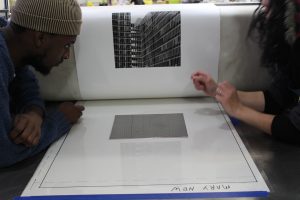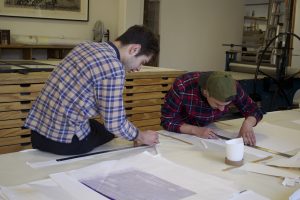With the recent opening of an exhibition of new works by Mary Wafer, entitled Ninth Floor, we at David Krut Projects took some time to speak with our printers who help make the works possible. We sat down with Kim-Lee Loggenberg, Neo Mahlasela and Chad Cordeiro to better understand the technical approach to creating the works.
David Krut Projects: How do these prints differ to previous works printed at the David Krut Workshop (DKW) by Mary Wafer?
Neo: The introduction of cold colour and a greater variety of tone is one thing to note that marks a graduation in Mary’s approach. The use of linear forms and superimposition has already been an aspect she explored in her previous print work; what differs in how she has used these recently is that there has been a leaning towards a play on the optical as opposed to spatial impressions.

DKW: Wafer has created a large-scale woodblock print as part of this body of work. Could you take us through the technical process of printing the woodblock?
Chad, Caroline, Nathaniel, Sbongiseni and Oliver:
In this specific case, the block was too large to fit onto our presses at DKW. Therefore, we hand-printed the block. Through a variety of tests (or what we call proofs) we found that utilizing the flat round qualities of plastic spoons and door knobs gave us the best results. First, we would layer the ink onto the surface of the block using brayers (special printmaking rollers), covering the surface evenly. Using a registration system we created specially for the block, we laid our paper down and started applying pressure over the entire surface.

Several layers were added to create a subtle shift in tone including:
- Rubbing up black (A neutral black ink)
- Transparent base (Shifting the white tone of the paper to a yellow)
- Portland stiff black (An intense matte black to accentuate certain areas)
DKW: Which work has been the most difficult to print technically?
Kim-Lee: So far the woodblock has proven the most technically difficult to print. There are many technical aspects to take into consideration. Not only is the block hand-printed but it also has multiple layers of varying black tones that give it depth. So both the printing process as well as the conceptual aspects of the print have been difficult to navigate.
DKW: Which work have you found to be the least taxing to print?
Kim-Lee: Mary’s smaller plates are the least taxing to print. They are a continuation from the “John Vorster Square” print she created earlier in the year so we are thoroughly familiar with the printing process and printing two plates at this stage is simple. The wiping is also fairly straightforward.
DKW: As a printmaker, what is your view of the recent works by Mary Wafer?
Neo: They are a great example of how one can exploit the minimal use of tone and colour to create striking dimension and sharpness.
Kim-Lee: Having watched Mary create the plates its both interesting and exciting to see these images come to life through each step of the creation process, it makes them even more enjoyable to print knowing how they were produced. The way she’s created her lines and tones is quite unique and her approach to the etching process feels fresh and inventive. The images are great!
Chad, Caroline, Nathaniel, Sbongiseni and Oliver:
Process, a key aspect in the creation of most works of art, is what we felt was the fuel powering Mary Wafer’s most recent exhibition Ninth Floor. While many artists’ conceptual integrity and technical skill are represented solely through the final product; Mary tackles both aspect of the creative process. Our first introduction to the work was in the form of a large-scale woodblock which, when hung in the final show, helped contextualize a “way of looking” at a structure representing something more than just architectural ideologies, but rather a shared social, political and physical history. Through not only the woodblock, but by means of painting and etching Mary interrogated the linear aspects of the building and used that as platform for her process. The use of tape was both a technical decision we made to make inking the plate easier, as well as to mirror the way that Wafer makes some of her architectural paintings.

